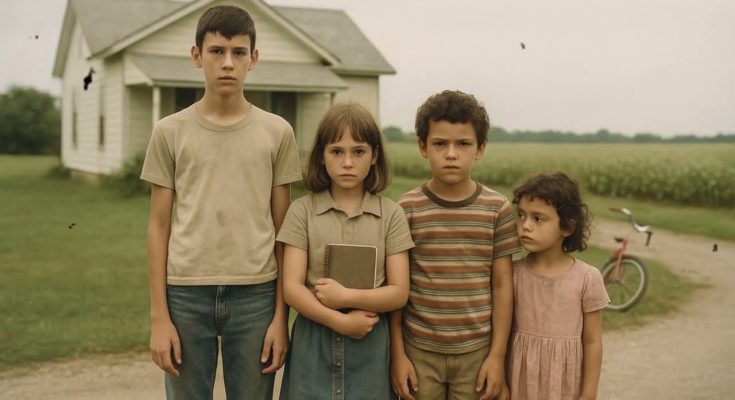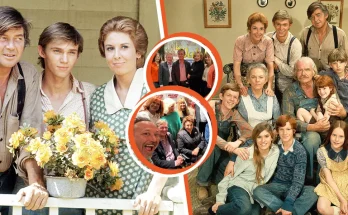Four Foster Kids Vanished in 1987 — Decades Later, A Hidden Basement Reveals Their Dark Secret… | HO

CARTER RIDGE, ILLINOIS — On a humid August morning in 1987, four foster children disappeared from a small group home on the edge of this southern Illinois town. Their foster father, Lester Simmons, told police they had run away. No one looked too closely. The case was closed in under 72 hours. The children’s names slipped from memory, their files buried in the bureaucratic churn of the state system.
For 36 years, the story of their vanishing was a local legend—one more sad tale in a region haunted by poverty and institutional neglect. But a recent discovery during a demolition project has shattered the official narrative, exposing a chilling secret that implicates not just a family, but the state itself.
This is the story of the Simmons foster home, the four children the system forgot, and the hidden basement that finally told the truth.
The House That Wasn’t Meant to Last
On May 17, 2023, a demolition crew arrived at the long-abandoned Simmons property. The house, built in 1958, was scheduled to be cleared for a new community park. By mid-morning, the excavator had hit something unexpected: a second basement wall behind the original foundation, and a narrow staircase descending into darkness.
What they found at the bottom was no ordinary storage room. Four rusted metal bed frames, a child’s shoe, and a bulletin board peppered with Polaroids. The air was thick with mildew and the silence was suffocating. The site was sealed, and the sheriff was called.
By nightfall, the past had returned—violent, undeniable, and demanding answers.
The Vanishing: August 1987
The original investigation was perfunctory at best. According to police records, Lester Simmons called 911 just after sunrise to report that Thomas (13), Eevee (11), Marcus (9), and Laurel (6) had vanished overnight. He sounded calm, almost bored. The children’s bedroom was neat, beds made, no clothes or toys left behind. The basement was locked. When pressed, Simmons claimed it was just for storage.
Deputy Rilene Hobbs, the first on scene, noted the odd stillness. “No footprints, no scuff marks, no sign four kids walked out,” she wrote in her report. “Room smells of bleach. Too clean.” But her concerns went unheeded. Within days, the sheriff labeled the incident a runaway case. The Department of Children and Family Services (DCFS) conducted a standard review, found nothing amiss, and renewed the Simmons’ foster license.
The file was closed. The children were never seen again.
A Basement, A Cabinet, and a Cabinet Full of Lies
When the hidden basement was uncovered in 2023, the Carter Ridge sheriff’s department moved quickly. The room was windowless, concrete, and empty except for a cot and a metal filing cabinet. Inside the cabinet were four folders—one for each missing child—containing original intake forms, behavioral notes, and dosage schedules. One page, marked in red ink, read: “Laurel still resists night training. Increased to 4mg if wake cycles persist.” There was no official seal, no initials, no indication who wrote it.
A hospital wristband with Laurel’s name was found beneath the cot. The air was stale, the lock rusted shut. The room had not been entered in decades.
The Investigation Reopened

Sheriff Lyall Mercer, who inherited the cold case, immediately called in state investigators. Among them was Elena Rivas, a specialist in historic child welfare cases. Rivas and Mercer began piecing together a timeline. They found that the Simmons home had received an unusual number of placements—children with behavioral issues, few family ties, and incomplete state records.
A second hidden room was discovered behind a drywall partition: a narrow cell with a cot, a bucket, and a wall speaker. Above the cot, in red crayon, four stick figures and the words: “Don’t tell. No one will come.”
The evidence pointed to something far darker than neglect or abuse. It suggested a system of psychological control, isolation, and possibly experimentation.
A Program Called Clementine
Digging through DCFS archives, Rivas found references to “Project Clementine”—a behavioral research initiative from the early 1980s. The project, supposedly unfunded, was spearheaded by Dr. Lester Simmons, the same man who ran the foster home. The proposal described “behavioral disruption and identity reassociation in state wards,” with methods including sensory conditioning, isolation, and chemical sedation.
The children were not just foster placements. They were subjects in an experiment.
Survivors and Ghosts
A breakthrough came when a former foster child, Hannah Coulter, came forward. Placed in the Simmons home in 1985, she described strict rules, red lights in the hallway, and “quiet time” in the basement. She remembered Laurel as “small, quiet, never ate with us. Lester said she needed special adjustment.”
A cache of VHS tapes was found in a hidden garage bunker. On one, Marcus, age nine, described “the red light” and what happened if you spoke when it was on: “I disappear.” Other tapes showed the children reciting numbers, answering to “subject” designations, and sitting listlessly under harsh lights while an unseen man—presumed to be Simmons—questioned them.
The State’s Complicity
The deeper Rivas and Mercer dug, the more they found evidence of state complicity. A grant renewal letter from the Department of Youth Services to Simmons referenced “acceptable behavior metrics” and directed the transfer or termination of “non-compliant subjects.” Seven children were listed in a transfer summary; only four were ever reported missing.
Records from a closed psychiatric center, Watson Ridge, showed the same project code—3619C—and more children with no names, only numbers. Interviews with former staff revealed that children marked with this code “weren’t ours. They belonged to someone else.”
The Survivor Speaks
In a house in Rock Falls, three hours north, investigators found a trove of evidence: photographs, tapes, journals. One tape, labeled “Subject 5, confession/closure,” featured a man in his 40s: “My number was always the same. Subject five. I was one of the ones who lived. They trained us to forget, to comply, to sleep on command and wake without memory. Simmons wasn’t alone. He was part of something bigger.”
He described Laurel: “She didn’t scream when it started. She just stopped talking. One day, she closed her eyes and didn’t open them again.”
The Final Ledger
A final tip led investigators to a ruined mission home in Grand Tower. In a rusted cabinet was a registry, page after page of names, photos, intake dates, and outcome codes. Simmons’ home had only handled seven children—but there were forty more in the ledger, scattered across a network of homes and institutions.
A memo ordered the program dissolved in 1990, archives destroyed, and all inquiries denied. But the records survived. So did some of the children.
Justice, Memory, and the Cost of Silence
In June 2023, a public inquiry in Chicago heard testimony from Rivas, Mercer, and—most powerfully—a man who identified himself as Thomas, “subject two.” “They tried to erase my memory, make me start over, but I remembered my brother’s name. I remembered the sound of the red door locking. Laurel didn’t make it. She was six. I remember her voice.”
The task force has since reopened 13 closed cases, uncovered new grave sites, and traced the funding trails that enabled the program. Survivors are speaking out—some under new names, others still using their subject numbers. The silence is broken, but the damage remains.
Epilogue: The Garden and the Ghosts
Where the Simmons house once stood, a sign now reads: “Future site of the Laurel Dorsy Memorial Garden, in memory of the forgotten children.” The grass grows over the old foundation. The wind carries the echo of voices—some remembered, some lost.
Not every child was saved. Not every truth will ever come to light. But enough has, for now. And sometimes, for the dead and the disappeared, enough is all they ask.



